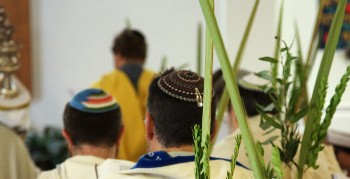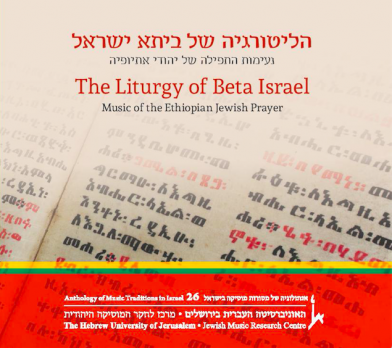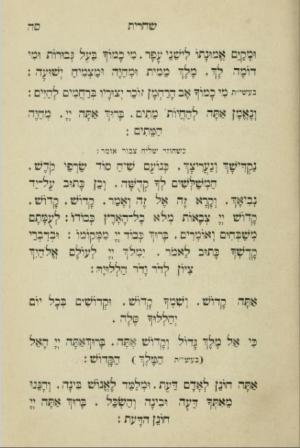Elohim Hashiveinu - New York Baroque - Eric Milnes
Elohim hashivenu: A liturgical insertion for the High Holidays in Salamone Rossi's version in Italy and beyond
Jewish liturgy evolved in a multidirectional process. Differences between diverse local versions and lineages of transmission crystallized into several minhagim (“customs” or “traditions”) once the printing press started to produce prayer books in rapidly increasing numbers to satisfy the expanding demand. Many unique liturgical passages, whose pedigree and paths of transmission remain to be investigated, were established in different minhagim, some of them only in one.
Such a passage is a string of three verses from Psalm 80 which is recited by the cantor before the reading from the second Torah scroll during the morning services of the Three Festivals and High Holidays, according to the minhagItaliani, also known as minhag Bnei Roma or minhag lo’azim. While strings of scattered verses from diverse psalms are a widespread phenomenon in Jewish liturgy, the text under discussion is unique in that the three verses belong to the same psalm, as opposed to other similar instances.
Let us look at these verses (Psalm 80: 4, 8, 20):

What distinguishes these verses scattered within one psalm is their obvious identity. In fact, they comprise a refrain dividing the song into “strophes,” a peculiar feature discussed widely in the scholarly literature about this Psalm. Interestingly, a fourth verse of the same psalm (Psalm 80, 15) belonging to the category of refrain is not included in our liturgical passage:
טו. אֱלֹהִים צְבָאוֹת, שׁוּב-נָא: הַבֵּט מִשָּׁמַיִם וּרְאֵה; וּפְקֹד, גֶּפֶן זֹאת
Clearly, the liturgist who set this passage noticed that verse 15 departed too much from the pattern of the other three verses, even though its opening and overall structure and content patently belongs to the same class. Apparently, the liturgist was attracted by the steady pattern of the three verses he selected and by their serial growth from five, to six and to seven words.
When exactly these verses entered the mahzor Italiani is hard to determine, but at the very latest one can point to the late medieval period. These verses already appear in the very early and magnificent Mahzor Soncino-Casalmaggiore printed in 1486/7 in the same liturgical function as they are performed in the present. This is a manifest testament to their early pedigree. As we shall see below, these verses also found their way, in a different liturgical function, to another minhag, that of the Romaniote (Greek) communities.
We should notice that other verses of different psalms are performed together with our three verses of Psalm 80 in the same liturgical section. We shall return to this feature later. Right now, let us move to the musical performance of the three verses.
The precious Leo Levi recorded collection of Italian Jewish musical traditions includes four versions of Elohim hashivenu, three from Italian cantors and one from a cantor from Salonika. Considering the time and material constraints of Levi’s recording capabilities back in the 1950s, this thick documentation of the three verses of Psalm 80 is highly remarkable if we consider their relatively secondary liturgical function, i.e. accompanying the second Torah scroll of Festivals.
Recordings of cantors from three different communities in Italy follow here:
Carlo Schönheit of Ferrara (b. Ferrara, 1900-1977) a member of a family of Holocaust survivors, NLI Y 177, recorded September 23, 1956.
Rabbi Marco Moshe Vivanti (1887-1968), Holocaust survivor and Rabbi in Rome, NLI Y 134, recorded in 1954.
Rabbi/Cantor Azelio Servi (b. Pitigliano), Holocaust survivor and cantor in Firenze after World War II, NLI Y 1301, recorded in Firenze on February 17, 1954.
Rabbi Vivanti's recording includes only the first two of the three verses, probably due to time constraints on the recording. The three performers add Psalm 28, 9 after the verses from Psalm 80, even though this verse does not appear in the printed prayer books. This fourth verse is sung to a different melody but is apparently an integral part of the liturgical section.
As one can hear, in spite of the notable differences between these interpretations, the three performances share some important features hinting at a common source: flexible beat; four-phrase structure; melodic contour ascending to the fifth degree on “hashivenu” and descending below the tonic on “panekha” (preparation of the end); and melismatic setting of the text (especially Schönheit’s rendition).
These verses of Psalm 80 would have remained a footnote in studies of Italian Jewish liturgical music, had they not had the good fortune of being set to music by the famous Italian-Jewish composer Salamone Rossi (c. 1570-c. 1630) in his work Hashirim asher lishlomo. Rossi’s setting of the three verses (but not of the ninth verse of Psalm 28 that is added in oral tradition) for four voices is a testimony of the fact that in the minhag Italiani this liturgical moment was a special “musical station” (i.e. a section of the liturgy that is musicalized) since early times.
Joshua Jacobson has suggested that Rossi’s setting of “Elohim hashiveinu” may have some relationship to the surviving melody found in the oral tradition of the Italian Jews. He based his assessment by comparing Rossi’s setting with Azelio Servi’s version, perhaps because he was unaware of the other recordings of the same text in the Leo Levi collection. In Servi’s recording, as with the other two we have heard, the three verses are performed cyclically, with three variants of the same melody without clear beat. These variants stem from the structure of the three verses of Psalm 80 which are almost identical, but not entirely, as we have seen, because each repetition adds one additional word.
While composing his setting Rossi had no option but to compose each of the three verses as a separate unit. This tripartite structure stresses the intensification implied by the growing number of words in each repetition of this pledge of the praying voice (the community of Israel). He accomplished that by making each verse more melismatic than the previous one to a point where the third verse is twice as long as the first one, even though it only has two more words than the first verse. He also chose to set the text in a modal framework that recalls the oral versions. All these factors: text, triple repetition of a musical unit, intensification with each repetition and modality, resulted of course in vague similarities between Rossi’s setting and Servi’s recording.
These similarities led Jacobson to his conclusion that Rossi knew at least one “real” Jewish (oral) melody. To make his case, Jacobson conveniently “reordered” the musical phrases as they appear in one of the four voices of Rossi’s work to correspond to the order of the phrases in the recorded example. Beyond this attempt to square the circle, one must credit Jacobson for noticing the substantial differences between Rossi’s piece and the archival recording.
Jacobson also stresses Rossi’s possible allegiance to a Christian source. The melodic and contrapuntal qualities of the opening closely resemble those of “Cum essem parvulus,” a motet by Orlande de Lassus. In addition, Jacobson even suggests that perhaps Rossi’s piece could have been the origin of the oral traditions recorded by Levi, an odd claim that even Harrán quotes in his scholarly edition of Rossi’s Hashirim asher lishlomo (Harrán 2003, vol. 13a, p. 35, note 40).
To conclude the discussion of Jacobson’s article, one sees how the allure of Rossi’s Hebrew compositions to modern scholars impacts the perception of his setting of “Elohim hashivenu.” Embedding Rossi’s work in the Italian oral tradition, whether as his inspiration or even as him being the originator of such oral tradition, endows him with an aura of authenticity valued by modern scholars. Undoubtedly, Rossi composed this text because already during his time it was an important musical section of the minhag Italiani at the composer’s community in early seventeenth-century Modena. The cantors he heard probably inspired him, but when setting the text to music he turned to the language of the spiritual Christian music of his time.
Is the practice of singing the three verses of Psalm 80 unique to Italy? The Leo Levi collection shows that singing “Elohim hashivenu” is not exclusive to communities of the Italian peninsula. His recording of cantor Moshe Halegua (1924-2012), a Holocaust survivor from Salonica, is remarkable for its rarity.[1]
Moshe Halegua, recorded in Salonica in 1957 (NLI, Y 3358)
These verses are not included in the Sephardic minhagim that we were able to consult and to which Halewa clearly belongs, in light of his heavily Ottomanized singing style. One possible reason is that Halegua may have served in one of the two Salonica synagogues which used the Mahzor Italiani until the 20th century, Italiya yashan and Italiya hadash. Prayer books printed in Venice on behalf of these congregations, such as the 1772 edition (see references below) attest to the use of the Italiani minhag in the overwhelmingly Sephardic community of Salonica.
Yet, even more intriguing is that Halewa sings (in the Turkish makam Nava) the first and third verses of the series (Psalm 80, verses 4 and 20) followed by the last two verses of the hosha’ana by the Byzantine liturgical poet Rabbi Eleazar HaKalir (c. 570-c.640), “Amen yish’akha asher ha’iroti.” This alphabetical poem ends with verses composing the acrostic of the poet starting “Avi ‘ad hash leta’arekh.” This last section of the hosha’ana is unique to the minhag Italiani. The final two verses, a blessing by the poet to his audience, are not part of the acrostic but they are an integral part of the poem, as attested to by most of the Genizah manuscripts containing it.[2]
Halegua repeats twice these verses (“May Shadday bless us and we shall live, and you will all be blessed/and they said, you shall be blessed to me, heralds and states”). The second repetition differs in its ending (“and also you will be blessed”), perhaps an impromptu change by the cantor honoring his guest, Leo Levi:
שדי ברכנו ונחייה, וכלכם ברוכים תהיו / ואמרו לי ברוך תהיה, מבשר [מבשר] ואומר
שדי ברכנו ונחייה, וכלכם ברוכים תהיו / וגם אתה ברוך תהיה, מבשר [מבשר] ואומר
Halegua’s version ties then the verses of Psalm 80 to another holiday and liturgical function, Hoshana Rabba, the seventh day of Succoth and the ending section (characterized by the words “mevaser veomer”) of the circuits of congregants in the synagogue with the Torah Scrolls and the Four Species. The connection of our three verses to Hoshana Rabba is apparently related to another liturgical minhag, the Romaniote. We may infer this from yet another field recording, this one carried out by another prominent ethnomusicologist, the late Prof. Amnon Shiloah, in Khalkis, Greece on August 9, 1970, from the local cantor Menashe Cohen (b. 1925; NLI Y 0278, 17:10).[3]
Cohen performs a version of the melody for the Psalm 80 verses that is remarkably similar to the three Italian versions recorded by Leo Levi. According to his spoken testimony, the cantor and the congregation perform the verses of Psalm 80 responsorialy. After the Psalm 80 verses Cohen sings “Ana Adonay hoshi’ah na, ana Adonay hatzliha na” (Psalm 118, verse 25) from the Hallel Psalms, hinting perhaps to the Hoshana Rabba connection.
Menashe Cohen, recorded August 9, 1970 (NLI Y 0278)
Much remains to be refined in our research of the liturgical insertion “Elohim hashivenu.” The present conditions of research under Covid-19 do not allow us to search deeper into the evolution of these three verses of Psalm 80 and their musical performances. Questions regarding their liturgical contexts (second Torah Scroll in the Hight Holydays and Festivals or Hoshana Rabba?), the different minhagim (Italiani, Romaniote, Sephardic from Salonica), and musical settings, remain open. However, from this short essay we can see, once again, that delving into the resources of the National Library of Israel Sound Archive has much to offer Jewish music scholarship.
Biography of Salamone Rossi at the JMRC website
Post-publication Addenda
From Enrico Fink (October 6, 2020) on hazzan Carlo Schonheit:
Carlo (known to everybody in Ferrara as “Carluccio') Schonheit died in 1977 [date now corrected above]. My family and I were very close to his son Franco, also a Buchenwald survivor, who passed away not a year ago. I sent the link to Gadi, Franco’s son, who lives in Milan, he was very much moved to find his grandfather’s voice on Yuval. Thank you on his behalf.
From Enrico Fink (October 6, 2020) on the reading from the second sefer on High Holidays in Rome:
The Italian traditional technique for singing the te'amim, which is still used in Italian rite synagogues in North Italy, has been abandoned in Rome in favour of the Sephardic reading (much to Levi’s chagrin). The only reading for which it is still used is the reading from the second sefer on High Holidays and chagim, so exactly after 'Elohim hashivenu.' A sort of Italian block coherently kept in one spot.
From Dr. Francesco Spagnolo (December 17, 2020), on hazzan Azelio Servi:
A quote from the journal Il Vessillo Israelitico LXX/1922 (XIX-XX), 297: PITIGLIANO […] Oltre ogni dire bene si svolsero i Iàmim Noràim preceduti dalle relative pratiche dell’Elul, Selichòd ecc., e visite pie al Bed Ahamin: onde frequentatissimo il S. Tempio in ambo le sezioni maschile e femminile con l’intervento dei limitrofi correligionari. Udita con la solita attenzione la predica rabbini, con fervore gli abituali Hazzanim, l’ex vice Rabbino sig. Salomone Servi, Raimondo Sorani, Azelio Servi, nonché l’ecc. Rabbino nostro [Gustavo Calò]. Fra i Seganim notammo i cavalieri sigg. Aristippo Sudan e Anselmo Colombo.
What this seems to suggest is that Servi was already active as a cantor in Pitigliano before 1922 ('gli abituali Hazzanim'). This is consistent with Levi's selection of informants, all typically reaching back to a musical memory that predates WW2, and sometimes goes back to the late 19th century. After the war, he was a cantor in Firenze (I think always in the 'hazzan volontario' rubric, but I would need to confirm that).
Endnotes
[1] The voice of Cantor Halegua can also be heard in the CD Romaniote and Sephardic liturgical hymns. Moshe Halegua and Samuel Cohen (1913-2000), edited by Sakis Negrín, produced by the Jewish Museum of Greece.
[2] I am thankful to Prof. Shulamit Elitzur from the Hebrew University of Jerusalem for enlightening me about this poem.
[3] Cantor Cohen’s voice is discussed extensively by Gabriel A. Zuckerberg in his honor’s thesis, “Mikra Yiannena: Romaniote Chanting for Shabbat Evening in Greece and New York City,” Dartmouth College, 2020. I thank Gabriel for pointing out to me this recording of “Elohim hashivenu” that is not specified in the catalogue of the National Library.
References
Don Harrán (ed.), Salamone Rossi – Opera Omnia, 13 vols. Middleton: American Institute of Musicology, Neuhausen: Hänssler-Verlag, 1995-2003 (Corpus Mensurabilis Musicae 100)
Joshua R. Jacobson, “A possible influence of traditional chant on a synagogue motet of Salomone Rossi,” Musica Judaica 10, no. 1 (1987-88), pp. 52-58.
Mahzor shel kol hashanah kefi minhag q”q italiyani, volume 2, Venice 1772.






